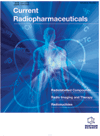- Home
- A-Z Publications
- Current Radiopharmaceuticals
- Previous Issues
- Volume 8, Issue 1, 2015
Current Radiopharmaceuticals - Volume 8, Issue 1, 2015
Volume 8, Issue 1, 2015
-
-
PET/CT Dose Planning for Volumetric Modulated arc Radiation Therapy (VMAT) -Comparison with Conventional Approach in Advanced Prostate Cancer Patients
More LessAuthors: Kalevi Kairemo, Nigora Rasulova, Timo Kiljunen, Kaarina Partanen, Aki Kangasmaki and Timo JoensuuMolecular imaging is the only way of defining biological target volume (BTV) for externalbeam radiation therapy (EBRT) and may be used for advanced targeting in dose planning and dose painting. There are, however, no reports about the EBRT response when dose planning is based on BTV target definition in advanced prostate cancer. Clinical and biochemical results of two clinically equal group of patients with advance Read More
-
-
-
SPECT-CT in Radiotherapy Planning, with Main Reference to Patients with Breast Cancer
More LessAuthors: Sonya Sergieva, Iglika Mihaylova, Elena Alexandrova, Milena Dimcheva and Luigi MansiThe aim of modern intensity-modulated radiotherapy (IMRT) and volumetric-modulated arc therapy (VMAT) is to define the target areas including the smallest non-invaded margins, thus reducing the radiation dose to radiosensitive organs. To reach this goal, these methods require a more precise target delineation by imaging to better define the viable part of the tumor. Image-guided selection and demarcation of Gross Tu Read More
-
-
-
Planning of External Beam Radiotherapy for Prostate Cancer Guided by PET/CT
More LessAuthors: Finn Edler von Eyben, Kalevi Kairemo, Timo Kiljunen and Timo JoensuuIn this paper, we give an overview of articles on non-choline tracers for PET/CT for patients with prostate cancer and planning of radiotherapy guided by PET/CT. Nineteen articles described 11C-Acetate PET/CT. Of 629 patients 483 (77%, 95% CI 74% - 80%) had positive 11C-Acetate PET/CT scans. Five articles described 18F-FACBC PET/CT. Of 174 patients, 127 (73%, 95% CI 68% - 78%) had positive scans. Both tracers detecte Read More
-
-
-
Hypoxia PET Tracers in EBRT Dose Planning in Head and Neck Cancer
More LessAuthors: Marina Hodolic, Jure Fettich and Kalevi KairemoOver the years, external beam radiotherapy (EBRT) has been used in the treatment management of many malignancies, including head and neck squamous cell carcinomas (HNSCC). Hypoxia is a common feature in HNSCC. Hypoxic segments in HNSCC have proven to be more resistant to radiotherapy. The ability to identify hypoxia using SPECT and PET tracers has been investigated since the late 1970s. Nitroimidazole-bas Read More
-
-
-
The Current Role of PET/CT in Radiotherapy Planning
More LessAuthors: Sze Ting Lee and Andrew M. ScottPositron Emission Tomography (PET) is increasingly being used in radiotherapy planning, with the development of hybrid imaging technology such as PET/CT allowing more accurate volumes being generated for treatment with external beam radiation. This article will discuss the use of FDG PET in radiotherapy planning of various types of malignancies, as well as some pitfalls and practicalities of integrating PET/CT into radiothera Read More
-
-
-
The Use of 68Ga-DOTA-(Tyr3)-Octreotate PET/CT for Improved Target Definition in Radiotherapy Treatment Planning of Meningiomas – A Case Report
More LessAuthors: Hanna Grzbiela, Rafal Tarnawski, Andrea D’Amico and Malgorzata Stapor-FudzinskaDue to somatostatin receptor expression in meningiomas, PET with somatostatin analogs appears to be useful in radiotherapy treatment planning. We report the case of a 63-year-old man diagnosed with meningioma of the left frontal lobe in 2011. He underwent total tumor excision (pathology was atypical meningioma WHO 2) and radiotherapy, but one year after the completion of treatment, he complained about diplopia and l Read More
-
-
-
Monitoring Kidney Function in Neuroendocrine Tumor Patients Treated with 90Y-DOTATOC: Associations with Risk Factors
More LessAuthors: Anne K. Arveschoug, Stine M. J. Kramer, Peter Iversen, Jorgen Frokiaer and Henning GronbaekPeptide receptor radionuclide therapy (PRRT) is an established treatment for progressive neuroendocrine tumours with nephrotoxicity as the limiting factor. It is therefore important to monitor kidney function changes after PRRT treatment. We aimed to investigate kidney function by different methods and during a 4-hour and a 24-hour amino acid (AA) infusion protocol. We measured the Glomerular Filtration Rate (GF Read More
-
-
-
Preparation and Biological Evaluation of 99mTc-Labelled Phenazine Dioxides as Potential Tracers for Hypoxia Imaging
More LessThe aim of this study was to investigate the capability of phenazine dioxides, recognized bioreductive antitumour agents, as carriers for 99mTc in order to generate potential theranostic radiopharmaceuticals towards hypoxic solid tumours. Two different phenazine dioxides were used as ligands for the 99mTc-tricarbonyl core in order to prepare the potential radiopharmaceuticals. The main physicochemical and biological properti Read More
-
-
-
Standardization of Procedures for the Preparation of 177Lu- and 90Y-labeled DOTA-Rituximab Based on the Freeze-dried Kit Formulation
More LessRituximab when radiolabelled with 177Lu or 90Y has been investigated for the treatment of patients with Non-Hodgkin’s Lymphoma. In this study, we optimized the preparation of antibody conjugates with chelating agent in the freeze-dried kit. It shortens procedures needed for the successful radiolabeling with lutetium-177 and yttrium-90 and assures reproducible labelling yields. Various molar ratios of Rituximab:DOTA (from 1 Read More
-
-
-
FDG-PET in the Evaluation of Brain Metabolic Changes Induced by Cognitive Stimulation in aMCI Subjects
More LessAuthors: Andrea Ciarmiello, Maria Chiara Gaeta, Francesco Benso and Massimo Del SetteCognitive training has reported to improve cognitive performance in Mild Cognitive Impairment (MCI) as well as in older healthy subjects. 18F-FDG-PET is widely used in the diagnoses of dementia for its ability to identify early metabolic changes. This study was aimed to assess the effect of cognitive stimulation on brain metabolic network and clinical cognitive performance. Thirty aMCI subjects were enrolled in the study and Read More
-
Volumes & issues
Most Read This Month
Article
content/journals/crp
Journal
10
5
false
en


